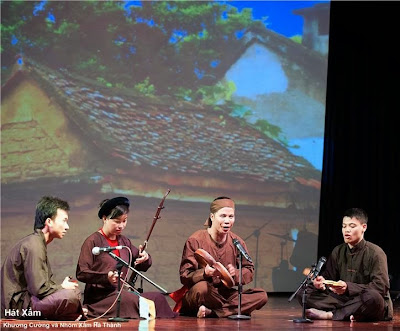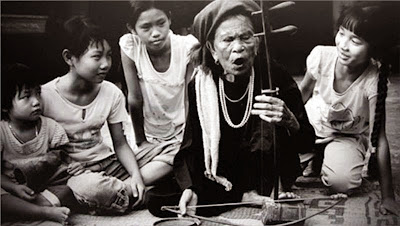Vicissitudes of Xam singing
 |
| Xam Artists |
Xam singing is a unique folk performing art which was born in over 700 years ago. Besides artistic values, Xam singing is a Vietnam folk music with humane, aesthetic features, ethical education and lifestyles of all strata of Vietnam society. Late 19th century and early 20th century is the heyday of Xam singing. At the time, it was not just simply a recreational activity of peasants, but also a way to make one's living in cities. It was taught from generation to generation. In the popularity of Xam singing, some blind or poor people who had the talent of music took advantage of Xam singing to earn a living. Since then, Xam singing became the "specialty" of the poor. The number of Xam singers was highest in the French occupation and early years of French resistance war.It is said that Xam singing was a spiritual "meal" of labor force for a long time. It mentioned many fields and contexts of daily life, and society. Not only does Xam singing the public, but also at events of weddings, funerals, and death's anniversary... One of the unique features of Xam singing art is a communication channel with a very powerful voice. During the resistance wars against the French and the US, Xam appeared and brought its role into play significantly. To encourage heroic struggle spirit of soldiers, the Xam singing artist Minh Sen (in Thanh Hoa) performed in battles to bring happiness to soldiers. And, Xam singing artist - Ha Thi Cau in Ninh Binh - is dubbed the last Xam singer of the 20th century. She composed the Xam song "Theo Dang tron doi" (Follow Party forever), even though she is illiterate. In the mid-20th century, Xam singing was associated with famous artists such as Nguyen Van Nguyen, Vu Duc Sac, Than Duc Chinh, Nguyen Phong Sac, Trum Khoan, Chanh Truong Mau, Dao Thi Man, Tran Thi Nhon, Tran Thi Thin, Nguyen Van Khoi, and other unknown artists. However, up until now, few artists of Xam singing exist, especially the artist considering Xam singing as a day job is Mrs. Ha Thi Cau the youngest wife of Truong Chanh Mau in Ninh Binh. From the 60s onwards, for different reasons Xam singing in Vietnam gradually disintegrated and not active anymore. Xam talented artists are too old. They gradually pass away and bring along unique artistic values of the art. Social life of Xam artists does no longer exist, Xam singing art has been forgotten, almost lost.
Origin of Xam singing
 |
| Xam performance |
According to document, Xam singing came into being in the 14th century. From its appearance to the first half of the 20th century, Xam singing was called different names like busking or troubadours. But in fact, Xam singing is a professional folk music genre, a unique oratorio style in traditional Vietnam music treasure with a deep, ingenious and attractive storytelling. In the feudal period, Xam singing was the voice of protesting and condemning the injustices, oppression, and vices of society. After wars, Xam folk songs were used as tools to promulgate policies and guidelines of the Party and State.Todays, in Vietnam tour packages in Hanoi, travelers have more chance to admire the unique art on old streets of the Vietnam’s capital. Xam singing is often performed on Hang Dao Street in Hanoi Old Quarter. It is said that Xam singing has eight main tunes: X©m chã, X©m xoan, Huê tình, X©m nhà trò, Nï oán, Hò bÑn mùa, Hát ai, and Thp ân. In Hanoi, there is a unique Xam singing style found nowhere - Xam singing on trams. Previously, to meet the satisfaction of audience, Xam singing artists added famous poems in Xam songs, which made the art become a second-to-none street music in Thang Long - Hanoi. In the system of Xam singing tunes, there are special and outstanding melodies which are often borrowed by other Vietnam art such as Cheo singing, Ca Tru singing... In the past, Xam singing was also performed in assembly halls. It proves that artists of Ca Tru singing respect Xam singing very much. They keep the word "Xam" in this tune, pointing out the origin of the melody.
 |
| Mrs. Ha Thi Cau |
Up until now, many people think that Xam singing is the singing style of the blind or beggars. In fact, the disadvantaged people use Xam singing to make their living. Therefore, Xam singing is a professional music type. The difference is that Xam singing stages are streets, banyan tree, berth, and courtyard... In the past, Xam singing was associated with daily life of Vietnamese peasants. Normally, after the harvest, Xam singing groups were invited to perform in rich households.Among Vietnamese traditional music, only Xam singing is regarded as a job to earn a living. As being a product of working men, the music characteristics are rustic and sincere, but possess profound ideological contents. Xam singing lyrics are not only rich in genres such as folk songs, proverbs, and poems of famous authors, but also very diverse in terms of content. The lyrics of Xam imply ethical teachings in life. The unique thing of Xam is that even though the content is about love, nature, war, or public relations... the Xam singing artists "tell" by a witty, catchy, and easy-to-remember music. The art really needs reserving and promoting by later generations. Source: http://www.alotrip.com